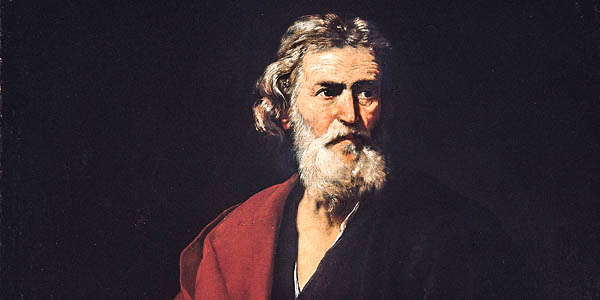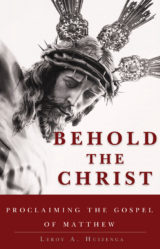By Leroy Huizenga
Leroy A. Huizenga is Administrative Chair of Human and Divine Sciences at the University of Mary in Bismarck, ND. He is the author of Behold the Christ: Proclaiming the Gospel of Matthew.

The Gospels are the theological center of the canon of Scripture, and the Gospel of Matthew stands first among the Gospels. Now the Bible and the Gospels within do not stand alone as mere documents to be read, believed, and acted upon. Rather, the Bible finds its true home in the liturgy, for the biblical texts were written for and used in worship from the first, both in ancient Israel and in the earliest Church. And as the Gospels are central to the canon of Scripture, the Gospels are fundamental to the liturgy of the Word: Catholics (and other liturgical Christians) sit for the Old Testament reading, the Psalm, and the Epistle, but stand for the reading of the Gospel. The Gospels are central to the liturgy of the Word because they are central to Scripture, and they are central to Scripture because they tell directly of the coming of Jesus Christ, the Son of God, who by the Incarnation is the unmediated and ultimate revelation of God himself to humanity, in the very flesh.
If the Gospels are the theological center of the canon, then the Gospel of Matthew stands at the forefront of the four Gospels as the most important Gospel. Calling the Gospel of Matthew the “First Gospel” need not be merely a clever way to duck questions of authorship (many modern scholars deny Matthew wrote it) but a way of recognizing its preeminence, for it has been regarded not only as the first among equals but even more as that Gospel which regulates readings of the others.
To distinguish among the contents of the canon of Scripture in this way is not to affirm some sort of “canon within a canon,” determined by prior confessional commitments with the effect of tossing wide swaths of Sacred Scripture overboard, but rather to recognize Scripture as a coherent story in which every word plays its role, a mosaic in which every piece matters and contributes to the picture of the whole. And for the historic Church, all roads lead to and from the Gospel of Matthew.
Why has the Gospel of Matthew achieved such preeminence in Christian history, not only among Catholics but also among Christians of the radical Reformation, such as the Amish and Mennonites?
First, the Gospel of Matthew has proven itself in liturgy and life. It is accessible. It has been found practical and relatively easy to read, preach, teach, and apply. The reason for this concerns, in turn, the breadth, depth, and clarity of its comprehensive content: stories teaching what became fundamental Christian doctrine are found in it, such as the Virgin Birth, the sacrificial crucifixion and Eucharist, and the resurrection and ascension of Our Lord, while Jesus himself issues plenty of direct and applicable teachings in his five great discourses (especially the beloved Sermon on the Mount) and instructs by example in the narrative sections.
Second, until relatively recently in Christian and academic history, the Gospel of Matthew was thought to be not only the first written but also an eyewitness account. The Gospel of Mark was thought to be a summary of the Gospel of Matthew; the prologue of the Gospel of Luke admits its account is derivative of Matthew’s (see Luke 1:1–4); and John was thought to have written a spiritual, theological Gospel complementing the three prior Gospels. And thus the Gospels received their canonical order for deep theological and historical reasons. In the canonical order, one also sees movement from the particularity of the Gospel of Matthew, situated as it is within the orbit of conservative normative and Pharisaic Judaism, to the universality of the Gospels of Luke and John, in which Gentile inclusion in the people of God is clear throughout.
A third, if subtle, reason for the Gospel of Matthew’s preeminence and position in the canon and Christian history as the first Gospel concerns its very particular nature. Salvation history in Israel and Judaism culminates in Jesus the Jew, as salvation is from the Jews (see John 4:22); the gospel is for the Jew first, then the Gentile (Rom 1:16). The Gospel of Matthew is concerned with fulfillment. All is fulfilled in the Matthean Jesus—the Scriptures, righteousness, obedience, the various Old Testament types Jesus completes. And so the Gospel of Matthew shows most clearly the culmination of salvation history in Jesus the Jew who was sent to Israel (Matt 10:5–6, 15:24) and then who commands his disciples to take him and his teaching to the nations (28:16–20).
The story of salvation history begins with the parents of the universal human race, but narrows as it goes on, running through the southern tribes of Judah and Benjamin, the Jews. But with the coming of Jesus Christ it begins to open up again, as it were, as the promises to Abraham concerning not just Israel or the Jews but indeed the whole human race are fulfilled. Part of God’s original promises to Abraham was that in him “all the families of the earth shall bless themselves” (Gen 12:3b)—not just Israelite families; it was a promise with universal import that the prophets reaffirmed in their own oracles (see, for instance, Isa 56:6–8).
You Might Also Like

Behold the Christ: Proclaiming the Gospel of Matthew, by Leroy A. Huizenga, reveals the significance of St. Matthew’s Jesus: He is Emmanuel, God with us always, who saves his people from their sins by dying for them. Keyed to the lectionary and featuring a section on the relevance of St. Matthew’s Gospel for our contemporary age, Behold the Christ will make the Gospel and indeed the Faith real to today’s readers.